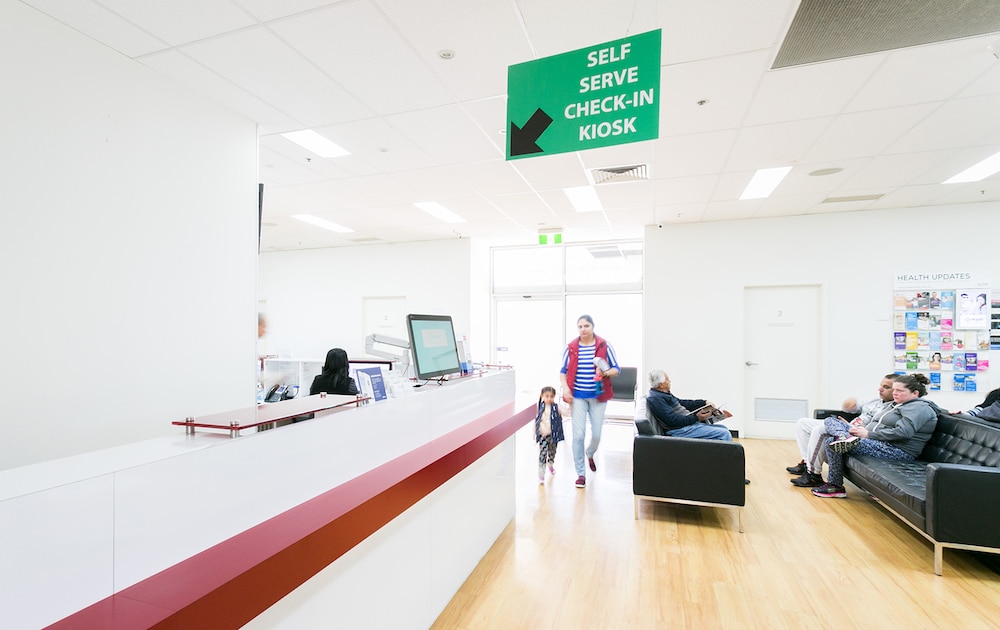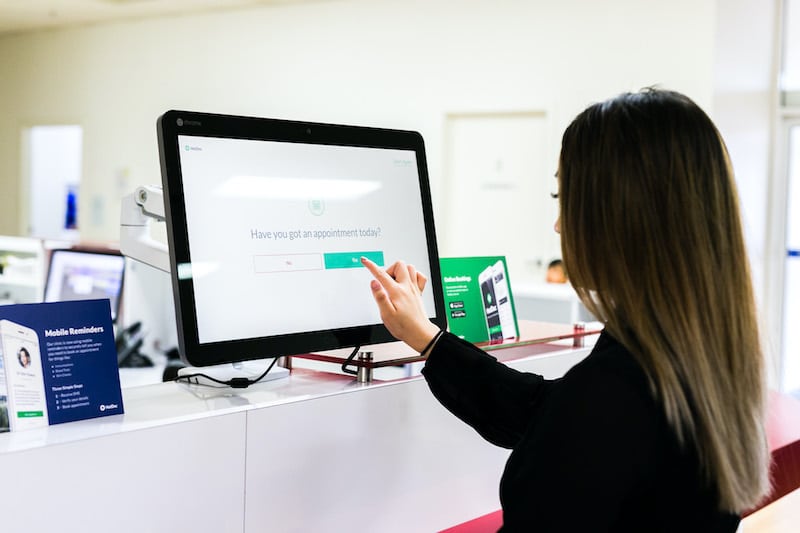In Airports, Fast Food and Medical Practices

In 2004, more than 80% of airline passengers checked in for their flight by going up to a ticket counter and speaking to an actual human being. Today, only about 20% of passengers check-in for their flight with a human agent. The rest use some sort of self-service kiosk. In other words, the ratios have been completely flipped.
The same thing is happening with fast food. According to one study, 67% of customers plan to place an order with a self-service kiosk within the next year. This is a 25% increase over the previous year.
Referring to checking in at the airport, John Tompkins, 51 years old from Sydney, says, “I prefer checking in with a kiosk. I feel like with the kiosk I have no problems spending the time that I need to make sure that I’m getting done exactly what I need done, as I see it.”
The result is that people are choosing to check-in the way they want to check-in. Passengers are also checking in faster. Not to mention, airlines are saving hundreds of millions of dollars in operational costs. One study estimated that it costs an airline $3.86 to check-in a passenger with a service employee compared to $0.16 with a self-service kiosk. This equates to a lot when you consider that Qantas had over 55 million passengers check in for flights in 2018.
Costs aside though, this adoption of self-service technology is doing something far more fascinating. It’s changing human behaviour. How? Well, let’s get to that in a moment. First, let’s dig into why this adoption is occurring.
What’s triggering the rise in self-service technology?
A study of supermarket transactions found that 55% of customers who used a self-service kiosk used it because “there was no line”. So they wanted to skip the queue.
A second study, which analysed hundreds of self-service transactions across five Australian supermarkets, found similar results. Most people said they used the kiosk to skip the queues that had gathered at staffed counters.
Perhaps, this isn’t surprising. It’s probably how you’ve found yourself using a self-service kiosk at some point. You saw a line at a counter and took a chance to use self-service to jump the queue. What is interesting, however, is the formula the researchers discovered that led to permanent adoption. Over hundreds of transactions they noticed that users almost always followed the same three steps prior to adoption.
Step 1: Need
Step one is driven by a need to solve a problem. For instance, the need to avoid the crowd gathered around a medical reception desk. The researchers call this ‘self efficacy’. It is the logical part of our brain kicking in and saying, maybe the kiosk will be faster than waiting in line.
According to the researchers, this self efficacy decision that prompts us to first try something new is rational in nature. In other words, it’s not an emotional decision. Our emotions kick in only after we’ve used the technology.
Step 2: Satisfaction
Next, the researchers found that what took someone from a one-off user of self-service technology to a frequent user was when the user felt emotionally satisfied with the technology. So if they were emotionally satisfied with the experience, they were happy to try it again. But what exactly makes a user emotionally satisfied?
The researchers say there are 5 key elements to an individual’s perceived ‘satisfaction’ of self-service technology. The technology must be (1) useful, (2) easy to use, (3) enjoyable, (4) not risky, and (5) controllable. So, if the technology does what the person expects it to do (1), is fast and simple to use (2), functions smoothly and as expected (3), doesn’t compromise privacy (4), and is easy to reverse steps and edit details (5), then the person is more than likely to use the technology again.
Step 3: Habit
When the technology satisfies a user often enough, a habit is formed.
The adoption curve
Typically this adoption follows a bell curve. It’s important to note that when we’re talking about adoption, that doesn’t mean a person uses the kiosk all of the time. Adoption simply means that a person, say a patient, will at least always consider using the technology. For instance, the moment there is a line at the desk, an adopter will turn to the kiosk without reservation.
The idea of the adoption curve is that in the early days of anything new there is a period where only a small percentage of users will change behaviour. 
Think about a check-in kiosk in a clinic waiting room. The practice manager sets it up in the foyer one morning. Most patients have never seen a check-in kiosk in a medical centre before and many have been checking in at the desk for years. Adoption is likely to move slowly, but there will be movement.
Even after a day, you’ll see a few patients begin trickling up to the kiosk to try it. These people are known as ‘Early Adopters’.
Early Adopters
‘Early Adopters’ love trying new things and being seen to be on the front foot. In the airport example right up at the beginning of this article, early adopters were those people checking in using self-service technology all the way back in 2004.
According to the University of New South Wales researchers, early adopters are typically “younger, better educated, less anxious, more ready to embrace new technology, and less in need of personal contact.”
Still, this is not always the case. John Tompkins, 51 years old from Sydney, says he puts himself in the early adopter category. “I think I’m an early adopter. I’ve always been tech-oriented. I used to work in light and sound, so we were always on the cutting edge of technology.”
Early Majority
Once these early adopters have paved the way, an ‘Early Majority’ will start using the technology. These are the people who have generally watched an early adopter from afar and seen that they have had a good experience with the device. They then experience a trigger event like a long line and they decide to try it.
The early majority are typically driven more by logic than emotion. They see a problem and want to solve it without much consideration of what the majority of people are doing.
HotDoc’s Check-In Kiosks are a great example of software in the early majority phase.
“In February 2017, the average HotDoc Check-In Kiosk was receiving 75 check-ins a day. Today, over 2 million check-ins later, the average Kiosk receives 130 check-ins a day, which is almost double the usage.”

A HotDoc Check-In Kiosk at the reception desk at Epping Healthcare in Victoria
Late Majority
Following the early majority are the ‘Late Majority’. These are typically people who require a little more reassurance. In other words, they are more emotional decision-makers. They look to the majority for guidance. When they see enough people using something they start to consider using it themselves.
There is nothing wrong with being in the late majority. I consider myself to be in this group. Generally, I let others be the guinea pigs. The transition to the smartphone, for instance. I definitely only bought a smartphone after I had watched majority of Australian adults using smartphones and getting benefit from them.
Laggards
Lastly, come the ‘Laggards’. This is a group of people who are slowest to adopt to new things. Back to the airport example, the laggards are those who to this day continue to skip the self check-in kiosks and head to the desk to speak to someone in person no matter how long the line. They would prefer to wait than risk something going wrong. And the day a business cuts check-in staff altogether, they are left helpless.
John says he recalls an airline who did this and the havoc it caused at the gate. He says, “I checked in to American Airlines when they didn’t have any gate agents. It was all self check-in. There were so many confused people who were really stressed out. I remember trying to help them, but you’re trying to fly as well. There always needs to be someone to help.”
This is an important point. There should always be the option to let people check-in in person. After all, this was one of the big discoveries made by the researchers from the supermarket study. They found that majority of people preferred using a mixture of both self-service and in-person check-in.
How self-service is changing human behaviour
But how exactly are self-service kiosks changing people’s behaviour? Well, the most interesting finding is how self-service is changing the way people make decisions. Whether people feel less judged, less rushed, or simply find it easier to understand information when it is communicated digitally, those who are using self-service technology are making very different decisions to those who aren’t.
“In 2004, McDonald’s introduced self-service. Almost immediately they saw a spike in order size. Customers who used a kiosk spent 30% more on food. The kiosks also increased beverage sales by 20%.”
Taco Bell saw a similar increase in order size when they made orders available via their new digital app. Customers spent 20% more on food when using the self-service technology compared to those who ordered with a human cashier.
The researchers concluded that when customers felt less judged, their decision-making changed. For instance, many people will say ‘no’ if you ask them out loud whether they want to upgrade their calories. Why? Because they feel uncomfortable. Remove this social friction and people behave more freely.
This same phenomenon occurred in a liquor store. It wasn’t the average spend that went up when self-service kiosks were introduced, but rather the sales of items with difficult-to-pronounce names. The study found that when the liquor store changed from face-to-face to self-service, the market share of difficult-to-pronounce items increased 8.4%. Researchers concluded that consumers feared being misunderstood or appearing unsophisticated in front of the clerks, so they often avoided the products altogether.
This also explains why a pizza chain that introduced online ordering saw special instruction requests increase by 14%. People feel more at ease making special requests when they don’t have to make them in person.
Also, people tend to remember more things when they don’t feel rushed. As John says, “When you’re standing person to person, you have a feeling that time is very short and you make snap decisions, and I don’t always make the best decision when I make a snap decision.”
People are also changing the way they make decisions by simply having a different way to digest information. As John explains, “I like seeing the information in front of me. I’ve always actually had an issue with understanding spoken language. Not a huge issue, but subtly. So, I feel more comfortable reading it than I do in a face-to-face situation.
“It’s not that I have any kind of social anxiety any more than anybody else, but in a situation where you’re rushed or in a noisy environment, I feel a lot more comfortable being able to read information than to have it spoken back to me.”
Jane Macrossan, Practice Manager at Battery Point Medical, who uses a HotDoc Check-In Kiosk, says this is one of the biggest benefits of the device. She says, “I like that the kiosk is private. Especially for those patients who just want to come in and check-in on their own, make themselves a coffee and slip into the waiting room.”
Conclusion
While adoption of self-service technology is not always going in the right direction – more calories being ordered at McDonald’s is not great for the health of the nation – there is certainly a benefit to the arrival of self-service technology. With anxiety and depression in Australia being at an all time high, helping to alleviate social anxiety and the feeling of being rushed, even just a little, is a step in the right direction.
Of course, check-in kiosks, especially in places like medical centres, will never fully replace reception staff. But that’s not the point. The point of self-service is not to remove in-person service. It’s simply to give patients the option to check-in the way they want to check-in, and to make their experience as satisfactory as possible.
The goal is to provide the best possible customer experience, whether that is in person or via self-service. Just like at an airport: self-service is a dream when there are lines at the desk and you’re late for a flight. But that’s only assuming someone is on standby to help you if assistance is needed. The ultimate customer/patient experience is a blend of the two.



